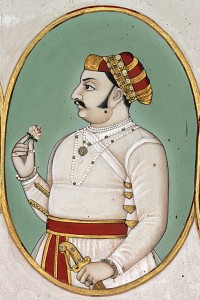Timur (died 18 February 1405), historically known as Tamerlane ("Timur the Lame"), was a Turco-Mongol conqueror and the founder of the Timurid dynasty in Central Asia.
Born into the Barlas confederation in Transoxiana during the 1320s or 1330s, Timur gained control of the Western Chagatai Khanateby 1370. From that base, he led military campaigns across Western, South and Central Asia and emerged as the most powerful ruler in the Muslim world after defeating the Mamluks of Egypt and Syria, the emerging Ottoman Empire and the declining Delhi Sultanate. From these conquests he founded the Timurid Empire, although it fragmented shortly after his death.
Timur is considered the last of the great nomadic conquerors of the Eurasian Steppe, and his empire set the stage for the rise of the more structured and lasting Gunpowder Empires in the 1500s and 1600s.
Timur envisioned the restoration of the Mongol Empire of Genghis Khan. "In his formal correspondence Temur continued throughout his life as the restorer of Chinggisid rights. He even justified his Iranian, Mamluk and Ottoman campaigns as a re-imposition of legitimate Mongol control over lands taken by usurpers". As a means of legitimating his conquests, Timur relied on Islamic symbols and language, referring to himself as the "Sword of Islam" and patronizing educational and religious institutions. He converted nearly all the Borjigin leaders to Islam during his lifetime. "Temur, a non-Chinggisid, tried to build a double legitimacy based on his role as both guardian and restorer of the Mongol Empire." Timur also decisively defeated the Christian Knights Hospitaller at Smyrna, styling himself a ghazi. By the end of his reign, Timur had gained complete control over all the remnants of the Chagatai Khanate, Ilkhanate, and Golden Horde and even attempted to restore the Yuan dynasty.
Timur's armies were inclusively multi-ethnic and were feared throughout Asia, Africa, and Europe,sizable parts of which were laid waste by his campaigns.[8] Scholars estimate that his military campaigns caused the deaths of 17 million people, amounting to about 5% of the world population.
He was the grandfather of the renowned Timurid sultan, astronomer and mathematician Ulugh Beg, who ruled Central Asia from 1411 to 1449, and the great-great-great-grandfather of Babur, founder of the Mughal Empire, which ruled parts of South Asia for over three centuries, from 1526 until 1857. Timur is also recognized as a great patron of art and architecture, as he interacted with Muslim intellectuals such as Ibn Khaldun and Hafiz-i Abru.
Born into the Barlas confederation in Transoxiana during the 1320s or 1330s, Timur gained control of the Western Chagatai Khanateby 1370. From that base, he led military campaigns across Western, South and Central Asia and emerged as the most powerful ruler in the Muslim world after defeating the Mamluks of Egypt and Syria, the emerging Ottoman Empire and the declining Delhi Sultanate. From these conquests he founded the Timurid Empire, although it fragmented shortly after his death.
Timur is considered the last of the great nomadic conquerors of the Eurasian Steppe, and his empire set the stage for the rise of the more structured and lasting Gunpowder Empires in the 1500s and 1600s.
Timur envisioned the restoration of the Mongol Empire of Genghis Khan. "In his formal correspondence Temur continued throughout his life as the restorer of Chinggisid rights. He even justified his Iranian, Mamluk and Ottoman campaigns as a re-imposition of legitimate Mongol control over lands taken by usurpers". As a means of legitimating his conquests, Timur relied on Islamic symbols and language, referring to himself as the "Sword of Islam" and patronizing educational and religious institutions. He converted nearly all the Borjigin leaders to Islam during his lifetime. "Temur, a non-Chinggisid, tried to build a double legitimacy based on his role as both guardian and restorer of the Mongol Empire." Timur also decisively defeated the Christian Knights Hospitaller at Smyrna, styling himself a ghazi. By the end of his reign, Timur had gained complete control over all the remnants of the Chagatai Khanate, Ilkhanate, and Golden Horde and even attempted to restore the Yuan dynasty.
Timur's armies were inclusively multi-ethnic and were feared throughout Asia, Africa, and Europe,sizable parts of which were laid waste by his campaigns.[8] Scholars estimate that his military campaigns caused the deaths of 17 million people, amounting to about 5% of the world population.
He was the grandfather of the renowned Timurid sultan, astronomer and mathematician Ulugh Beg, who ruled Central Asia from 1411 to 1449, and the great-great-great-grandfather of Babur, founder of the Mughal Empire, which ruled parts of South Asia for over three centuries, from 1526 until 1857. Timur is also recognized as a great patron of art and architecture, as he interacted with Muslim intellectuals such as Ibn Khaldun and Hafiz-i Abru.






